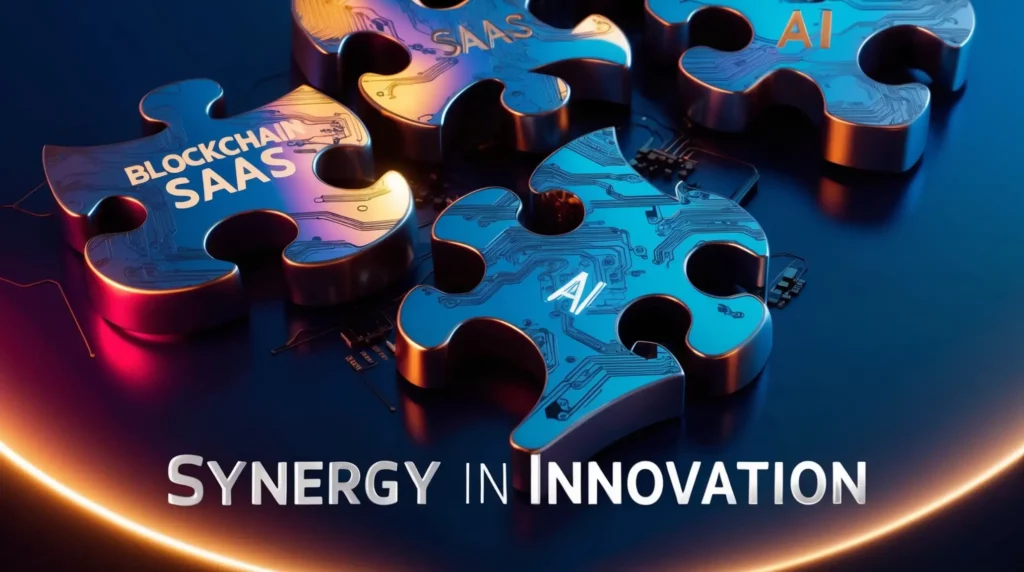How SaaS for Blockchain is Revolutionizing Technology

Our audience supports Ahcrypto. When you click on the links on our site, we may earn an affiliate commission at no extra cost to you. Learn More.
Introduction
SaaS solutions have transformed the tech industry by providing scalable, cost-effective, and easily deployable software services. When we think about blockchain technology, it creates an image of decentralized ledgers ensuring transparency and trust. These technologies are working together to create powerful outcomes.
This article explores how SaaS solutions improve security, simplify processes, and encourage innovation within the ecosystem. From strong security measures for smart contracts to cloud-based infrastructure services, the combination of SaaS and blockchain is shaping the future of tech.
But there’s more to this partnership than just that. For instance, AI also plays a significant role in this transformation. Look at our blog on AI in Various Industries to understand how it’s revolutionizing sectors like e-commerce and cybersecurity.
And when we talk about AI, we can’t ignore its potential in promoting sustainability. The article on AI Sustainability: Leveraging AI in 2024 delves into how artificial intelligence can advance sustainability goals and reduce environmental impact across sectors.
Furthermore, AI has proven to be a game-changer in improving customer experience. The article on Strategies to Improve Customer Experience with AI offers valuable insights into enhancing customer interactions through artificial intelligence.
Finally, let’s not overlook the impact of AI in logistics. The article on AI in Logistics: Top Use Cases and Industry Role sheds light on how real-time insights and predictive analytics are transforming the efficiency of logistics operations.
As we explore the synergies between SaaS, blockchain, and AI, we must recognize that these technologies are not just buzzwords but powerful tools driving innovation and reshaping industries.
Key Takeaways
Understanding Blockchain Technology

What is Blockchain Technology?
Blockchain technology is like the digital version of a ledger book. It records every transaction or data entry in a shared online record book accessible to multiple computers.
Decentralized Ledgers: Trust and Transparency
The key feature of blockchain is its decentralized ledger. Instead of relying on a single central authority (such as a bank) to manage transactions, blockchain distributes this responsibility among many participants in the network. This decentralized structure brings two important benefits:
- Trust: Each entry (or block) must be verified by multiple participants (nodes) before it can be added to the chain.
- Transparency: Every participant can view the entire ledger, making it extremely difficult to modify records without detection.
Smart Contracts: Self-Executing Agreements
Smart contracts are an advanced application of blockchain technology. They are essentially digital contracts that automatically execute when specific conditions are met.
Here’s an example to help illustrate how smart contracts work: let’s say you’re renting an apartment, and both you and the landlord have agreed to use a smart contract. The contract states that the security deposit will be returned to you once the lease ends and all conditions (such as no damages) are fulfilled. With a smart contract in place, there’s no need for intermediaries like lawyers or property managers to handle this process manually.
Smart contracts offer two main advantages:
- Automation: They eliminate the need for manual intervention by executing actions based on predefined rules.
- Security: Since smart contracts are stored on the blockchain, they benefit from its strong security measures, reducing the risk of fraud or tampering.
This seamless integration of trust, transparency, and automation makes the technology revolutionary and why it fits so well with SaaS solutions.
For more insights on how cutting-edge tech can optimize your operations, check out our guide at Harnessing AI for Sustainability Project Management. This article explores how harnessing AI for sustainability can optimize project management, reduce carbon footprints, and drive businesses towards a more sustainable future.
Additionally, here is a post that provides a comprehensive resource for debunking common AI myths and misconceptions. Understanding the truth behind these misconceptions about artificial intelligence is crucial to embracing its potential.
Furthermore, you might be intrigued by the application of blockchain technology in nonprofit software solutions. Lastly, if you’ve ever dreamed of teaching others and want to create engaging courses quickly, Unschooler uses AI to help anyone become a course creator. By leveraging AI-powered tools, Unschooler makes it easier than ever to build compelling courses at an accelerated pace.
The Synergy Between SaaS and Blockchain

SaaS-based services are a game-changer for businesses due to their scalability, cost-effectiveness, and rapid deployment. Think about how industries like finance and e-commerce leverage SaaS for efficient data management and customer engagement. For example, financial institutions use AI-powered SaaS tools to streamline risk management processes.
Key Use Cases of SaaS in Blockchain Technology
In the context of blockchain technology, these benefits translate into significant advantages:
- Infrastructure Management: SaaS platforms enable blockchain startups to handle complex infrastructure needs without hefty investments in physical hardware.
- Data Analytics: Utilizing SaaS for data analytics can help these networks process vast amounts of data seamlessly, driving more insightful decision-making.
- User Experience Enhancement: Customizable SaaS solutions can improve the user interface of decentralized applications (dApps), making them more accessible and user-friendly.
Case Study: Blockchain Startup Success
Consider the case of a leading blockchain startup that leveraged SaaS solutions to innovate its operations. By using cloud-based nodes and infrastructure services from top providers, they achieved on-demand scalability and enhanced network resilience. This strategic move allowed them to focus on core development activities while maintaining robust security measures.
The successful integration of SaaS into their operations is not an isolated incident. In fact, various sectors are witnessing the power of AI in conjunction with SaaS. For instance, the financial services sector has been revolutionized by AI-powered tools ranging from risk management to customer engagement. Additionally, as businesses embrace digital transformation, exploring the potential of AI and IoT becomes crucial for staying competitive in today’s landscape.
Furthermore, as cybersecurity threats continue to evolve, utilizing AI in cybersecurity becomes imperative to enhance detection, avoid cybercriminals, and defend against malware.
The application of AI is not limited to specific sectors or industries. For example, businesses across various domains can leverage AI customer support software to transform their customer service teams and improve overall customer engagement.
Ensuring Robust Security Measures for Smart Contracts through SaaS-based Tools and Services
Smart contracts are the backbone of these applications, enabling self-executing agreements without the need for third-party intervention. However, they come with their own set of vulnerabilities. High-profile breaches have shown how costly smart contract flaws can be. This is where SaaS solutions shine.
Importance of Mitigating Vulnerabilities
- Security Breaches: Remember the DAO hack? It resulted in a $60 million loss due to a vulnerability in the smart contract code. Such incidents underscore the importance of robust security measures.
- Proactive Auditing: Catching bugs post-deployment is risky and often too late. Proactive auditing during the development phase can save time, money, and reputation.
Leading SaaS Solutions for Smart Contract Auditing
- MythXFeatures: Automated security analysis for Ethereum smart contracts.
- Use Case: A blockchain startup used MythX to audit its crowdfunding smart contract, identifying critical vulnerabilities before going live.
- AlethioFeatures: Comprehensive analytics platform providing insights into blockchain transactions and smart contract performance.
- Use Case: Alethio’s analytics helped a DeFi project monitor contract interactions, ensuring transparency and trust among users.
- Anyblock AnalyticsFeatures: Offers monitoring and alerting services for blockchain networks.
- Use Case: A supply chain company integrated Anyblock Analytics to track smart contract executions across multiple network nodes, enhancing operational efficiency.
Improving Network Resilience and Performance with Cloud-Based Nodes and Infrastructure Services
Blockchain networks rely on a distributed architecture that necessitates robust infrastructure to ensure resilience and high performance. SaaS platforms offer significant advantages in this area.
Advantages of Cloud Providers
- Global Reach: Cloud providers like AWS, Google Cloud, and Azure offer a global footprint, ensuring low latency and high availability for blockchain nodes.
- On-Demand Scalability: Need more computing power? Scale up instantly without investing in physical hardware.
- DDoS Protection: Built-in DDoS protection mechanisms safeguard the networks from malicious attacks.
SaaS Platforms Enhancing Blockchain Infrastructure
- Saas Blocks Features: Provides tools to deploy and manage decentralized applications (dApps) across various cloud environments.
- Use Case: A fintech company used Saas Blocks to host its payment dApp on multiple cloud platforms, achieving seamless integration and enhanced user experience.
Real-World Impact
A logistics firm leveraged cloud-based nodes to maintain constant uptime for its blockchain tracking system. By using SaaS solutions for node management, the firm achieved:
- Reduced latency
- Improved data accuracy
- Enhanced customer satisfaction
Exploring More Resources
For those looking to dive deeper into compliance frameworks or enhance user experience design in SaaS products, check out our guide on SaaS compliance or the best practices in UX design.
The Future Landscape of SaaS-Enabled Blockchain Innovation

Expert Insights on Emerging Trends and Technologies
When we look at what’s coming next in the integration of SaaS and blockchain, there are three main areas to focus on:
- The combination of SaaS, AI, and the Internet of Things (IoT)
- Together, these three things are making blockchain technology more widely used. Think about smart cities where IoT devices work perfectly with blockchain to keep data safe and secure. Then, you can use AI-powered analytics to make this data even better.
- You might find it interesting to discover how AI and IoT are changing the way we live in cities. This article explores the application of AI technologies for public safety and more in sustainable smart cities.
- More SaaS Marketplaces for Blockchain Applications Designed for Specific Industries
- We see increasingly specialized SaaS platforms for finance, healthcare, and supply chain management industries. These platforms have tools made just for those industries, which makes these applications work even better.
- Curious about no-code solutions? Check out these top 10 no-code SaaS tools for building your MVP without coding. These innovative platforms can help jumpstart your startup.
- Possible Problems in the Future and Industry Collaboration
- Like with any new technology that’s changing fast, problems will arise. Some examples are how different systems work together, following the rules set by the government and making sure everything is safe.
- People in the industry must work together to solve these problems.
- Using big sets of data and AI in a smart way can also help fix these problems. Learn more about how big data and AI drive innovation. This article explains how big data and AI work in tandem to drive innovation and growth.
Looking at these trends gives us a small look into what could happen. SaaS solutions will keep making this technology even better than before. Additionally, if you’re interested in unlocking the power of SaaS analytics tools for your SaaS business, you should explore these top 10 SaaS analytics tools that can significantly contribute to your business growth.
Conclusion
The combination of SaaS and blockchain marks a fundamental shift in digital business operations, enhancing efficiency, security, and scalability. Companies should explore Blockchain IaaS, PaaS, and SaaS services tailored to their needs.
For cost-effective investment optimization, visit Mastering SaaS Optimization to Improve Your Funds. To integrate ethical AI with SaaS, see AI Trust: Ensuring Ethical and Reliable AI Systems.
Consult Ultimate Guide to Startup SaaS Financial Models for SaaS startup financial modeling guidance. To transform e-commerce with AI, read Transforming AI in e-commerce for 2024.
Embracing blockchain and SaaS positions organizations as leaders in innovation and competitiveness. The future of blockchain is here – seize it!
Keep updated on all of our latest tips here.
FAQs (Frequently Asked Questions)

Scott Evans
Hey there, I’m Scott Evans, your friendly guide at AhCrypto! I’m all about breaking down complex SaaS, AI, and tech topics into digestible insights. With me, you’re not just keeping up with the tech world; you’re staying ahead of the curve. Ready to dive into this exciting journey? Let’s get started!






